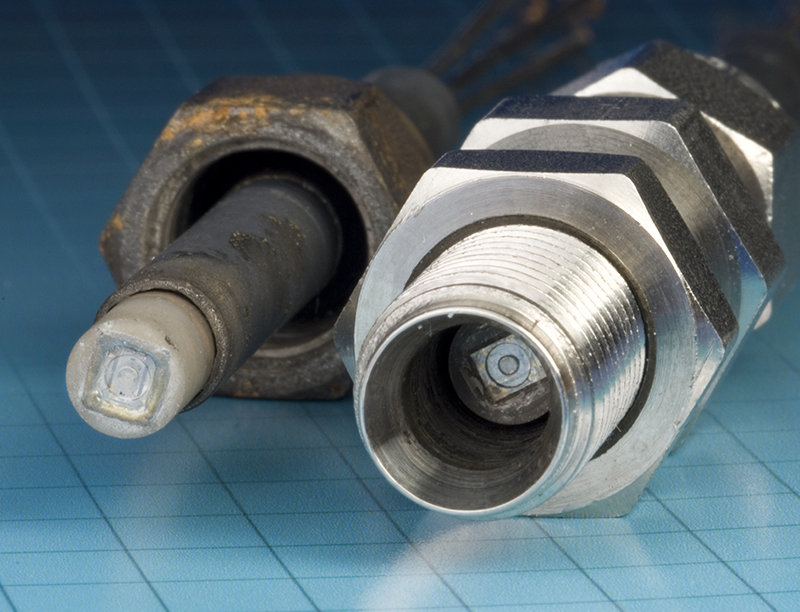
Sensors Increase Productivity in Harsh Environments
Originating Technology/NASA Contribution
A team of scientists at Glenn Research Center, operating under the Aeronautics Research Mission Directorate’s Aviation Safety and Fundamental Aeronautics programs, developed a series of technologies for testing aircraft engine combustion chambers. The team, led by electronics engineer Dr. Robert Okojie, designed a packaging technique and chip fabrication methods for creating silicon carbide (SiC) pressure sensors to improve jet engine testing. According to Okojie, the team was “working to develop pressure sensors that would be used to more accurately measure pressure inside jet engine combustion chambers where the temperature is very high.” Okojie’s team also understood that “due to their temperature limitations, conventional pressure sensors are usually kept further away from the sensed environment. As a result, measurement accuracy is generally compromised. In addition, vital dynamic information could be lost due to frequency attenuation. This new technology is meant to be inserted in close proximity with the sensed environment, thus eliminating these disadvantages.”
SiC-based pressure sensors fabricated using these NASA technologies can operate for over 130 hours at 600 °C. These durable chips are applicable in engine ground testing and short-duration flight test instrumentation. Kathy Needham, director of the Technology Transfer and Partnership Office at Glenn, explains, “We have been spearheading the use of silicon carbide in sensors for some time now—the material withstands high temperatures and allows measurements to be taken closer to the source. As an added advantage, the new sensors are less complex than current, similar sensors, reducing the likelihood of performance failure, allowing them to be manufactured relatively inexpensively, and reducing system maintenance needs.”
These factors also lend the technology to other uses, including commercial jet testing, deep well-drilling applications where pressure and temperature increase with drilling depth, and in automobile combustion chambers. As Okojie explains, “I see this technology being inserted in commercial jet engines and in deep wells while prospecting for oil. In commercial engine use, more accurate measurement of pressure would lead to improved engine safety by monitoring precursors of thermo-acoustic instability that leads to flame-out, efficient combustion of fuel and reduction of unwanted emission of hydrocarbons and nitrogen oxides. In deep well drilling, it would allow for longer term insertion into the wells, thereby significantly saving the cost of equipment maintenance and down time.”
Partnership
To explore and develop these commercial uses, California’s San Juan Capistrano-based Endevco Corporation, a division of the Meggitt PLC group, licensed three patents covering the high-temperature, harsh-environment silicon carbide pressure sensors from Glenn. Collaboration between the two dates back to 2000, when, during combustion tests, Glenn used an Endevco silicon-based accelerometer as a benchmark device to validate its SiC accelerometer. The test results showed that the NASA device operated as well as the Endevco model, but the NASA-developed device had the added advantage of operating at much higher temperatures. This led to discussions between Endevco and Glenn about licensing opportunities to acquire Glenn’s SiC pressure and accelerometer sensor fabrication and packaging technologies.
Endevco met with the Glenn researchers on numerous occasions during the following years. After witnessing the advantages of the NASA technology first-hand, the company licensed the three NASA patents for commercial development with the caveat that Okojie would continue to work on the project and help the company overcome any outstanding technical issues. Okojie agrees with the importance of this arrangement. “The transfer of this technology to the commercial sector,” he says, “would extend the utilization of the products beyond the government (NASA, DOE, and DoD) to civil aviation, with derivative applications particularly in the efficient management of fuel combustion and the reduction of unwanted combustion byproducts.”
Building on years of already successful collaboration, the partnership now steers these novel technologies toward their envisioned commercial applications. “Endevco is the ideal partner to bring this NASA technology to market, since the company already has a proven track record in the field and is now willing to commit to making this new technology accessible to industry,” Needham elaborates. “The company,” she continues, “is planning a new product line, enabling this high-performance NASA technology to achieve widespread use.”
Product Outcome
Founded in 1947, Endevco supports its customers with a global network of manufacturing and research facilities, sales offices, and field engineers, providing trusted solutions for the world’s most challenging measurement applications. In its more than 60 years of operation, Endevco has become a world leader in sensing solutions for demanding vibration, shock, and pressure applications. It was the company NASA trusted when it needed a benchmark device for its testing, and when the company saw that NASA had developed technologies that could improve the sensing field, it acted on the opportunity to license the cutting-edge know-how. NASA’s SiC technology is Endevco’s latest cutting-edge offering.

Dr. Robert Okojie, a researcher in the Sensors and Electronics Branch at Glenn, is a testament to the quality of a research environment that nurtures talent and ability at Glenn Research Center.

Glenn Research Center licensed three patents, covering high-temperature, harsh-environment, silicon carbide pressure sensors, to Endevco Corporation.













